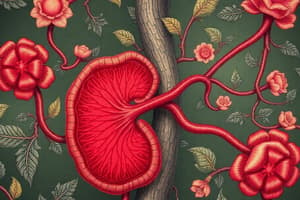Podcast
Questions and Answers
What is a glycocalyx?
What is a glycocalyx?
A layer of non-ionic polysaccharides which locates to the outer surface of the cell wall in some bacterial species.
Which of these can be found in the capsule of bacteria?
Which of these can be found in the capsule of bacteria?
Polysaccharides
All bacteria have a capsule.
All bacteria have a capsule.
False (B)
What is the difference between a capsule and a slime layer?
What is the difference between a capsule and a slime layer?
What is a characteristic of bacteria that have a capsule?
What is a characteristic of bacteria that have a capsule?
Which of these is NOT a function of the bacterial capsule?
Which of these is NOT a function of the bacterial capsule?
What is the main reason why capsules are considered a virulence factor?
What is the main reason why capsules are considered a virulence factor?
What is the key characteristic of bacterial capsules that makes them difficult to stain directly with acidic or basic stains?
What is the key characteristic of bacterial capsules that makes them difficult to stain directly with acidic or basic stains?
What is the purpose of the Maneval's capsule staining method?
What is the purpose of the Maneval's capsule staining method?
What is the main difference between the acidic and basic stains used in the Maneval's method?
What is the main difference between the acidic and basic stains used in the Maneval's method?
Why does the acidic stain not stain the bacterial capsule?
Why does the acidic stain not stain the bacterial capsule?
Why doesn't the basic stain stain the capsule?
Why doesn't the basic stain stain the capsule?
Why does the basic stain stain the bacterial cell?
Why does the basic stain stain the bacterial cell?
Why does the basic stain stain the background of the slide?
Why does the basic stain stain the background of the slide?
What is the final result of the Maneval's capsule staining method?
What is the final result of the Maneval's capsule staining method?
Heat fixation is an appropriate technique when staining bacterial capsules.
Heat fixation is an appropriate technique when staining bacterial capsules.
Why is heat fixation not suitable for capsule staining?
Why is heat fixation not suitable for capsule staining?
What is the most appropriate method for preparing bacterial samples for capsule staining?
What is the most appropriate method for preparing bacterial samples for capsule staining?
What is the purpose of endospores for bacteria?
What is the purpose of endospores for bacteria?
What is the role of the endospore in the survival of the bacteria?
What is the role of the endospore in the survival of the bacteria?
How do endospores differ from vegetative cells?
How do endospores differ from vegetative cells?
Which of these factors can trigger the formation of endospores in bacteria?
Which of these factors can trigger the formation of endospores in bacteria?
Endospores can be killed by autoclaving.
Endospores can be killed by autoclaving.
Which genus of bacteria is known for producing endospores?
Which genus of bacteria is known for producing endospores?
Endospores are easily stained with standard staining techniques.
Endospores are easily stained with standard staining techniques.
What is the specific stain used for endospores, and what makes it effective?
What is the specific stain used for endospores, and what makes it effective?
What is the purpose of using gentle heating during endospore staining?
What is the purpose of using gentle heating during endospore staining?
Why is safranin used as a counterstain in endospore staining?
Why is safranin used as a counterstain in endospore staining?
What is the most common method for enumerating bacterial growth?
What is the most common method for enumerating bacterial growth?
How does the colony count method allow you to estimate the number of bacteria in a sample?
How does the colony count method allow you to estimate the number of bacteria in a sample?
What is the dilution factor used in the colony count method?
What is the dilution factor used in the colony count method?
How does the dilution factor influence the accuracy of the colony count method?
How does the dilution factor influence the accuracy of the colony count method?
The colony count method is particularly useful for enumerating microaerophilic bacteria.
The colony count method is particularly useful for enumerating microaerophilic bacteria.
The colony count method can be used to determine the viability of bacteria?
The colony count method can be used to determine the viability of bacteria?
Heat-labile organisms cannot be enumerated using the colony count method.
Heat-labile organisms cannot be enumerated using the colony count method.
What is an antimicrobial agent?
What is an antimicrobial agent?
Flashcards
Glycocalyx
Glycocalyx
A layer of non-ionic polysaccharides found on the outer surface of the cell wall in some bacteria.
Capsule
Capsule
A thick and dense layer of polysaccharides firmly attached to the cell wall.
Slime layer
Slime layer
A loose and unorganized layer of polysaccharides that is loosely attached to the cell wall.
Capsule-forming bacteria
Capsule-forming bacteria
Signup and view all the flashcards
Non-capsule-forming bacteria
Non-capsule-forming bacteria
Signup and view all the flashcards
Capsule's virulence
Capsule's virulence
Signup and view all the flashcards
Capsule and attachment
Capsule and attachment
Signup and view all the flashcards
Capsule and phagocytosis
Capsule and phagocytosis
Signup and view all the flashcards
Capsule and immune evasion
Capsule and immune evasion
Signup and view all the flashcards
Capsule and nutrient scarcity
Capsule and nutrient scarcity
Signup and view all the flashcards
Capsule and dehydration
Capsule and dehydration
Signup and view all the flashcards
Capsule's staining properties
Capsule's staining properties
Signup and view all the flashcards
Maneval's Capsule staining method
Maneval's Capsule staining method
Signup and view all the flashcards
Congo Red
Congo Red
Signup and view all the flashcards
Acidfuchsin
Acidfuchsin
Signup and view all the flashcards
Halo spaces
Halo spaces
Signup and view all the flashcards
Klebsiella pneumoniae
Klebsiella pneumoniae
Signup and view all the flashcards
Cheat fixation
Cheat fixation
Signup and view all the flashcards
Endospores
Endospores
Signup and view all the flashcards
Sporulation
Sporulation
Signup and view all the flashcards
Mother cell
Mother cell
Signup and view all the flashcards
Endospore characteristics
Endospore characteristics
Signup and view all the flashcards
Endospore germination
Endospore germination
Signup and view all the flashcards
Schaeffer-Fulton Staining method
Schaeffer-Fulton Staining method
Signup and view all the flashcards
Malachite green
Malachite green
Signup and view all the flashcards
Safranin
Safranin
Signup and view all the flashcards
Bacterial growth
Bacterial growth
Signup and view all the flashcards
Bacterial enumeration
Bacterial enumeration
Signup and view all the flashcards
Colony Forming Units (CFU)
Colony Forming Units (CFU)
Signup and view all the flashcards
Agar plate method
Agar plate method
Signup and view all the flashcards
Study Notes
Capsule Stain
- Glycocalyx is a layer of non-ionic polysaccharides located on the outer surface of the cell wall in some bacterial species.
- The cell wall of some species is made of amino acids such as D-glutamine.
- Capsule is a thick, dense layer of polysaccharides firmly attached to the cell wall.
- Slime layer is an unorganized layer of polysaccharides loosely attached to the cell wall.
- Bacteria with capsules have mucoid (mucus-like) smooth colonies.
- Examples of encapsulated bacteria include Klebsiella pneumoniae, Streptococcus pneumoniae, and Bacillus anthracis.
- Bacteria without capsules have rough colonies.
Capsule Stain-Pathogenicity
- Capsules are a major virulence factor that mediates attachment to host tissues.
- Capsules interfere with phagocytosis (anti-phagocytic).
- Some bacterial species have capsules made of polysaccharides similar to those found in host tissues, hence preventing immune system recognition.
Capsule Staining Methods
- Capsule staining methods are indirect: using a non-ionic dye (e.g., Congo Red (acidic)) to stain the background and a basic dye (e.g., Acid fuchsin) to stain the bacteria.
- Maneval's capsule staining method is an indirect method.
Endospore Staining
- Endospores are metabolically inactive cells that provide protection from harsh environmental conditions.
- They are formed within the mother cell (sporulation).
- Endospores can remain viable for thousands of years.
- Endospores are formed in response to stress like lack of nutrients, inappropriate temperature, and pH changes.
- Bacteria form endospores to survive harsh environments.
Endospore Location
- Endospores can be located centrally, subterminally, or terminally within the mother cell.
Endospore Staining Techniques
- Endospores are resistant to regular staining procedures.
- Schaeffer-Fulton method employs Malachite green and subsequent counterstaining (e.g., Safranin or basic fuchsin) under gentle heating to stain endospores green and the cells red.
Bacterial Enumeration
- Microbial growth is the increase in the number of cells in a microbial population.
- Factors affecting bacterial growth include nutrients, oxygen concentration, pH, and temperature.
- Techniques for estimating bacterial cell counts include counting bacterial cells under light microscope or electronic particle counter, measuring the mass of bacterial cells (e.g, dry weight), measuring turbidity, and colony count.
- Dilution is essential prior to counting colonies since large populations cannot be accurately counted.
- Performing serial dilutions beforehand helps to accurately count bacteria and their densities.
Antibiotic Susceptibility Testing
- Antimicrobial agents are substances that kill or inhibit the growth of microorganisms without harming the host cells.
- Bacterial pathogens can develop resistance to antibiotics.
- Susceptibility testing methods include broth dilution, agar dilution, disk diffusion, antibiotic strips, and computerized systems.
- The minimum inhibitory concentration (MIC) is the lowest antibiotic concentration that prevents microbial growth.
- The minimum bactericidal concentration (MBC) is the lowest concentration that kills the bacterium.
Studying That Suits You
Use AI to generate personalized quizzes and flashcards to suit your learning preferences.





